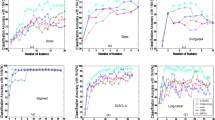Abstract
The min-max modular network has been shown to be an efficient classifier, especially in solving large-scale and complex pattern classification problems. Despite its high modularity and parallelism, it suffers from quadratic complexity in space when a multiple-class problem is decomposed into a number of linearly separable problems. This paper proposes two new pruning methods and an integrated process to reduce the redundancy of the network and optimize the network structure. We show that our methods can prune a lot of redundant modules in comparison with the original structure while maintaining the generalization accuracy.
This work was supported in part by the National Natural Science Foundation of China via the grants NSFC 60375022 and NSFC 60473040.
Preview
Unable to display preview. Download preview PDF.
Similar content being viewed by others
References
Lu, B.L., Ito, M.: Task Decomposition Based on Class Relations: a Modular Neural Network Architecture for Pattern Classification. In: Cabestany, J., Mira, J., Moreno-Díaz, R. (eds.) IWANN 1997. LNCS, vol. 1240, pp. 330–339. Springer, Heidelberg (1997)
Lu, B.L., Ito, M.: Task Decomposition and Module Combination Based on Class Relations: a Modular Neural Network for Pattern Classification. IEEE Trans. Neural Networks 10, 1244–1256 (1999)
Lu, B.L., Shin, J., Ichikawa, M.: Massively Parallel Classification of Single-trial EEG Signals Using a Min-Max Modular Neural Network. IEEE Trans. Biomedical Engineering 51, 551–558 (2004)
Lu, B.L., Ichikawa, M.: Emergent On-line Learning in Min-max Modular Neural Networks. In: Proc. of IEEE/INNS Int. Conf. on Neural Networks, Washington DC, USA, pp. 2650–2655 (2001)
Wilson, D.R., Martinez, T.R.: Reduction Techniques for Instance-based Learning Algorithms. Machine Learning 38, 257–286 (2000)
Lian, H.C., Lu, B.L.: An Algorithm for Pruning Redundant Modules in Min- Max Modular Network. In: Proc. 14th National Conference on Neural Network, pp. 37–42. Hefei University of Technology Press (2004) (in Chinese)
Gates, G.W.: The Reduced Nearest Neighbor Rule. IEEE Transaction on Information Theory IT-18-3, 431–433 (1972)
Blake, C. L., Merz, C. J.: UCI (1998), ftp://ftp.ics.uci.edu/pub/machine-learningdatabases
Lu, B.L., Ichikawa, M.: Emergent Online Learning with a Gaussian Zero-crossing Discriminant Function. In: Proc. IJCNN 2002, pp. 1263–1268 (2002)
Author information
Authors and Affiliations
Editor information
Editors and Affiliations
Rights and permissions
Copyright information
© 2005 Springer-Verlag Berlin Heidelberg
About this paper
Cite this paper
Yang, Y., Lu, B. (2005). Structure Pruning Strategies for Min-Max Modular Network. In: Wang, J., Liao, X., Yi, Z. (eds) Advances in Neural Networks – ISNN 2005. ISNN 2005. Lecture Notes in Computer Science, vol 3496. Springer, Berlin, Heidelberg. https://doi.org/10.1007/11427391_103
Download citation
DOI: https://doi.org/10.1007/11427391_103
Publisher Name: Springer, Berlin, Heidelberg
Print ISBN: 978-3-540-25912-1
Online ISBN: 978-3-540-32065-4
eBook Packages: Computer ScienceComputer Science (R0)




